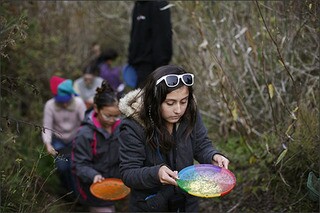
By the time they enter kindergarten, white children know significantly more about science than their peers of other races, and wealthier kids know more than less well-off peers.
And those gaps are not often erased in school: According to a new study published by the American Educational Research Association, knowing more about science in the first years of school is the strongest predictor of whether a student scores well on 8th grade science tests.
Concerns about racial inequities in the sciences are not new, nor are they limited to K-12 schools. NAEP scores have long indicated gaps between racial groups in the sciences among children; conservation groups, tech companies, the national parks, and other science-oriented organizations have been focused on diversifying their adult employees and audiences.
But just when those gaps begin, and how school and education policies can help or hurt, has been less studied.
Gaps Persist
In a new article AERA’s Educational Researcher journal, a group of researchers from Penn State University and the University of California set out to investigate whether achievement gaps in science are stable (some students come in behind and remain behind), compensatory (educational opportunities in school or other factors lead students who come in behind to eventually catch up with their peers), or cumulative (some students come in behind, become disheartened or disinterested or receive fewer opportunities, and fall even further behind over time).
Authors Paul L. Morgan, Marianne M. Hillemeier, and Steve Maczuga, of Penn State, and George Farkas of the University of California, Irvine, used data from the National Center for Education Statistics to track 7,750 students from kindergarten through 8th grade. Students in the NCES data set took a test in kindergarten and 1st grade that included both science and social studies, and a science achievement test in 3rd, 5th, and 8th grade.
Wealthier students started out with more knowledge in kindergarten and pulled even further ahead by 8th grade. The gap between white and black students also increased over time.
In the same period of time, the gap between white students and Asian students, who start out behind their white peers, narrowed. The gap between white and Hispanic students also decreased slightly. Most of the gaps present in 8th grade were also present in 3rd grade.
“It’s never too late.”
So what can policymakers, educators, and parents do to address the persistent or growing gaps?
“You want to have a sense of urgency about this,” Penn State’s Morgan said in an interview. “These trajectories start to diverge early on and remain stable over time. But you don’t want to think it’s too late. It’s never too late. We just need to make sure we’re directing our efforts in a way that begin much earlier.”
The researchers suggest that exposing more students to science as young children could make a difference. (More nature-focused preschools?) Morgan said that can be as simple as conversing with children about the things they encounter in day-to-day life. “This can be playful and engaging,” he said.
But, the researchers write, some students may be particularly disadvantaged over time by being in lower-resourced schools or having lower-quality science teachers. The issue is particularly pressing, they write, as schools are becoming increasingly segregated by race and by growing income disparities. If at-risk children had access to stronger science programs in early childhood and in elementary and middle school, the researchers suggest, they could perhaps be set on the path toward more knowledge about and interest in the sciences. Interest in the sciences has been shown to decline around the start of middle school, so catching children early might be especially important in this subject.
The paper does not examine particular instructional approaches or trends in children’s knowledge before they enter school.
The researchers found that doing well in math and English/language arts predicted doing well in science, so growth in these subjects may be tied to improvements in science, too.
Photo: Andrea Garcia-Milla, a 6th grader at Terman Middle School, brings back a water sample from a pond during a week in 2011 at NatureBridge in Sausalito, Calif. Ramin Rahimian for Education Week
Related stories: